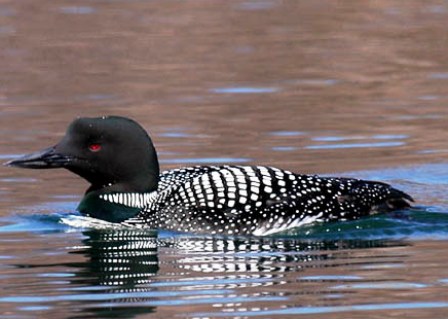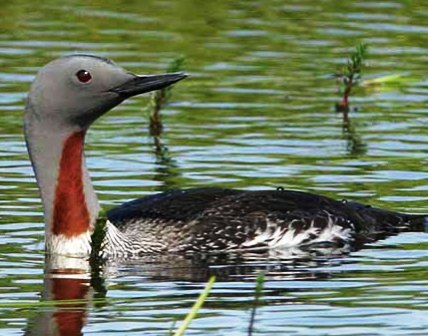Discover Florida Nature
It's time to explore the natural Florida


|
|
|
|
|
 Common
Loon- The common loon, with its exquisite breeding plumage and
yodel-like call, has come to symbolize wilderness and northern lakes to
many people. But once the breeding season ends in Alaska, Canada and the
northern U.S., loons head south to winter along the Atlantic and Gulf
coasts. Thousands of loons dot the bays and open oceans surrounding
Florida and are a very visible part of the winter coastal landscape.
While in Florida, both male and female winter loons have a white
underside and a gray-brown head, neck and back. In late spring along the
Gulf Coast and in north Florida lakes, a few birds acquire breeding
plumage just prior to their migration north. Common
Loon- The common loon, with its exquisite breeding plumage and
yodel-like call, has come to symbolize wilderness and northern lakes to
many people. But once the breeding season ends in Alaska, Canada and the
northern U.S., loons head south to winter along the Atlantic and Gulf
coasts. Thousands of loons dot the bays and open oceans surrounding
Florida and are a very visible part of the winter coastal landscape.
While in Florida, both male and female winter loons have a white
underside and a gray-brown head, neck and back. In late spring along the
Gulf Coast and in north Florida lakes, a few birds acquire breeding
plumage just prior to their migration north. Common loons are heavy-bodied birds that sit low in the water just offshore. They are known as the great northern diver by British birders and for good reason. They dip their heads below the surface to visually locate prey and then power through the water with large webbed feet. Streamlined and efficient underwater swimmers, loons can quickly move in on small fish, crabs and invertebrates, usually swallowing them while still submerged. Most dives are shallow and last less than a minute, but deep dives may last up to five minutes. Loons are adapted to life on the water; their legs are located so far back on their bodies that they are one of the few birds that cannot walk on land. Instead they must crawl or push their bodies onto land or into their nests. The loon call, described as a maniacal musical laugh, a falsetto wail, a yodel and a tremolo, is commonly heard during the breeding season. Loons are mostly quiet during the winter in Florida, though they occasionally call in late morning or early evening just before spring migration. In the north, loons are most vulnerable to mercury contamination in acid lakes, while oil spills in coastal waters affect the wintering birds. Habitat loss, human disturbance and mortality related to lead poisoning and commercial fish nets also stress the population.  Red-Throated
Loon- The red-throated loon is the smallest, slightest of the
divers. It is distinctive among loons not only in size, but also in
behavior, vocalizations, locomotion, and other aspects of life history.
The Red-throated Loon, unlike other loons, does not need to patter on
the water's surface on a long takeoff, but rather can take flight
directly from land if necessary. Most loons must paddle furiously across
the surface of the water before becoming airborne, but the small
Red-throated can practically spring directly into the air from land, a
useful ability on its tundra breeding grounds. Whereas only males of
other loon species vocalize, both male and female Red-Throated
Loon- The red-throated loon is the smallest, slightest of the
divers. It is distinctive among loons not only in size, but also in
behavior, vocalizations, locomotion, and other aspects of life history.
The Red-throated Loon, unlike other loons, does not need to patter on
the water's surface on a long takeoff, but rather can take flight
directly from land if necessary. Most loons must paddle furiously across
the surface of the water before becoming airborne, but the small
Red-throated can practically spring directly into the air from land, a
useful ability on its tundra breeding grounds. Whereas only males of
other loon species vocalize, both male and female Red-throated Loons make calls, often together. The Red-throated Loon is the only loon that regularly forages far from its breeding territory, returning from distant lakes or the sea with fish for the young. Unlike other loons, the Red-throated Loon does not carry its young on its back. The Red-throated Loon breeds in the Aleutian Islands, Alaska, and Canadian Arctic south to British Columbia, northern Manitoba, and Newfoundland. This loon spends winters south along Pacific coast to southern California and along the Gulf Coast and Florida. The attractive breeding plumage of this loon is seldom seen in temperate latitudes, because the birds molt just before they depart for their nesting grounds. While not as social as Pacific Loons, wintering Red-throated Loons may gather in large numbers where food is abundant. They are common on salt water of all depths but frequently forage in shallow bays and estuaries rather than far out at sea. Because their legs are located so far back, loons have difficulty walking on land and are rarely found far from water. The birds are extremely vulnerable to oil pollution; many have been killed along both coasts as a result of recent oil spills. The red-throated loon breeds in low tundra wetlands, bogs, and ponds in forests. In migration, flocks stage on large lakes. Winters in relatively shallow, sheltered marine habitat. A group of loons has many collective nouns, including an "asylum", "cry", "loomery", "raft", and "water dance" of loons. |
|
|
Advertise | Privacy Statement | Dog Encyclopedia | Video |Contact | Alaska Nature |
|